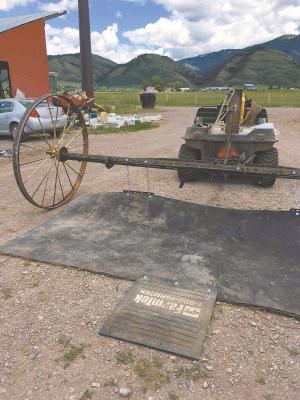2018 - Volume #42, Issue #6, Page #16
[ Sample Stories From This Issue | List of All Stories In This Issue | Print this story
| Read this issue]
Moving Dam Makes Flood Irrigation Fast, Easy
 |
 |
“I can watch the water spread out and adjust my speed moving down the ditch,” says Anderson. “If I need to, I can stop and let more water run over the side of the ditch.”
While center pivots and other types of sprinklers have edged out flood irrigation in a lot of areas, in Anderson’s valley, it remains the most economical.
“We have only 30 frost free days a year,” he says. “It is hard to justify expensive irrigation equipment with our short seasons and limited crops.”
However, dropping temporary dams into ditches to flood a field always meant a lot of heavy labor. Dams had to be weighed down with rocks and wood placed behind them for support. A few years ago Anderson tried pulling a temporary dam behind a ditcher hooked to his tractor.
“It was fine on dry land, but if I hit wet soil, I could sink in,” says Anderson. “I realized the wheels and axle from an old dump rake would be ideal and the Argo would be perfect to pull it.”
Anderson now has 3 moving dams that he has made by attaching plastic sheets and conveyor belt to rakes stripped of their tines.
“I use pieces roughly 4 or 5 ft. wide and the span of the rake, usually about 12 ft. long,” says Anderson. “I chain the conveyor belt to the rake. With ag plastic sheets, I just tie them to the rake with twine.”
With the sheet attached, he simply drives down the ditch in the direction of the flowing water. When he slows or stops, a head of water builds up behind the dam and flows over the lower side of the ditch.
“On our soils, we need a good head of water to spread out across the field,” he says. “If it’s not enough, the water will quickly sink in.”
While conveyor belting is heavy enough to follow the contour of the ditch and hold the water, light plastic bagging material can float to the surface.
“I hang weights on the plastic to hold it down,” says Anderson. “Then I just need to go slow so I don’t outrun the water.”
Contact: FARM SHOW Followup, Ron Anderson, P.O. Box 66, Grover, Wyo. 83122 (ph 307 248-8543).

Click here to download page story appeared in.

Click here to read entire issue
To read the rest of this story, download this issue below or click here to register with your account number.




